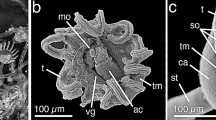Summary
The tentacles of the apodous holothurian Genus Leptosynapta have been studied by use of transmission and scanning electron microscopy. The gross anatomy, water vascular system, fibre systems and ectoneural nerve ring are described. A fuzzy coat of attenuated filaments covers the surface of the tentacle, broken only by secretory ducts. A cuticle underlies the fuzzy coat. Bacteria are common in the subcuticular space. Fixation without osmium gives poor preservation of the surface coats. The epidermis consists of a single layer of columnar cells consisting of Type-1, Type-2, support, goblet and uniciliated cells. Type-1 cells secrete electron-dense material and appear to be homologous to adhesive cells of the tentacles of other holothurians. The support cells contain large, granular vesicles not found in other holothurians. Goblet cells contain flocculent mucus and have an apical cilium. Goblet cells are not found in other holothurian tentacles and may function to lubricate and wrap adhering particles to aid their ingestion. The uniciliated cells are rare, poorly developed and the cilium does not extend past the cuticle. The ultrastructure of the tentacles is discussed in relation to those of other holothurians.
Similar content being viewed by others
References
Bereiter-Hahn J, Matoltsy AG, Richards KS (eds) (1984) Biology of the integument, vol 1, Invertebrates. Springer, Berlin Heidelberg New York, pp 839
Bouland C, Massin C, Jangoux M (1982) The fine structure of the buccal tentacles of Holothuria forskali (Echinodermata, Holothuroidea). Zoomorphology 101:133–149
Cameron JL, Fankboner PV (1984) Tentacle structure and feeding processes in life stages of the commercial sea cucumber Parastichopus californicus (Stimpson). J Exp Mar Biol Ecol 81:193–209
Cobb JLS, Moore A (1986) Comparative studies on receptor structure in the brittlestar Ophiura ophiura. J Neurocytol 15:97–108
Frankboner PV (1978) Suspension feeding mechanisms of the armoured sea cucumber Psolus chitinoides Clark. J Exp Mar Biol Ecol 31:11–25
Feral JP, Massin C (1982) Digestive systems: Holothuroidea. In: Jangoux M, Lawrence JM (eds) AA Balkema, Rotterdam, pp 191–212
Gotto RV (1984) Observations on Synaptiphilus tridens (T and A Scott), an ecto-associate of holothurians. Crustaceana, Suppl 7:214–216
Hammond LS (1982) Analysis of grain-size selection by deposit-feeding holothurians and echinoids (Echinodermata) from a shallow reef lagoon, Discovery Bay, Jamaica. Mar Ecol Prog Ser 8:25–36
Hermans CO (1983) The duo-gland adhesive system. Ocean Mar Biol Annu Rev 21:281–339
Holland ND, Nealson KH (1978) The fine structure of the echinoderm cuticle and the subcuticular bacteria of echinoderms. Acta Zool (Stockholm) 59:169–185
Hyman LH (1955) The Invertebrates, vol IV. Echinodermata. McGraw-Hill, New York, pp 763
McKenzie JD (1985) The tentacular ultrastructure of dendrochirote holothurians — a comparative SEM study. In: Keegan BF, O'Connor BD (eds) Proceedings of the Fifth International Echinoderm Conference, Galway, Balkema, Rotterdam, pp 445–450
McKenzie JD (1987) The ultrastructure of the tentacles of eleven species of dendrochirote holothurians studied with special reference to the surface coats and papillae. Cell Tissue Res 248:187–199
Martinez JL (1977) Estructura y ultraestructura del epitelio de los podios de Ophiothrix fragilis (Echinodermata, Ophiuroidea). Biol R Soc Esp Hist Nat Biol 75:275–301
Massin C (1982) Food and feeding mechanisms: Holothuroidea. In: Jangoux M, Lawrence JM (eds) Echinoderm nutrition, Rotterdam, Balkema, pp 43–55
Powell EN (1977) Particle size selection and sediment reworking in a funnel-feeder Leptosynapta tenuis (Holothuroidea, Synaptidae). Int Rev Ges Hydrobiol 62:485–508
Roberts D (1979) Deposit-feeding mechanisms and resource partitioning in tropical holothurians. J Exp Mar Biol Ecol 37:43–56
Smith TB (1983) Tentacular ultrastructure and feeding behaviour of Neopentadacyla mixta (Holothuroidea: Dendrochirota) JMar Biol Ass UK 63:301–311
Stubbs TR, Cobb JES (1982) A new ciliary feeding structure in an ophiuroid echinoderm. Tissue Cell 14:573–583
Williams G (1954) Fauna of Strangford lough and neighbouring coats. Proc R IR Acad 56B:29–133
Author information
Authors and Affiliations
Rights and permissions
About this article
Cite this article
McKenzie, J.D. Ultrastructure of the tentacles of the apodous holothurian Leptosynapta spp (Holothurioidea: Echinodermata) with special reference to the epidermis and surface coats. Cell Tissue Res. 251, 387–397 (1988). https://doi.org/10.1007/BF00215848
Accepted:
Issue Date:
DOI: https://doi.org/10.1007/BF00215848




